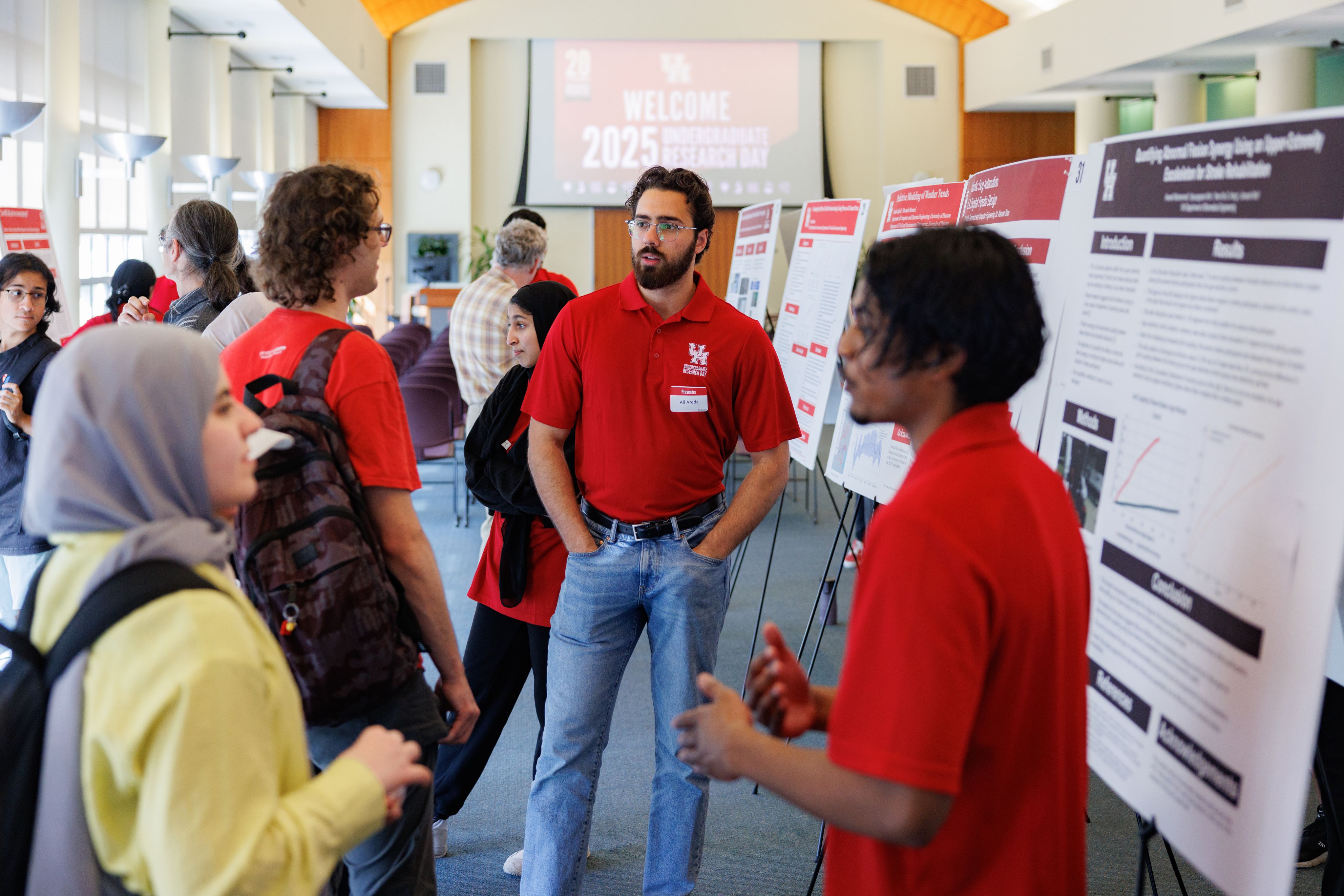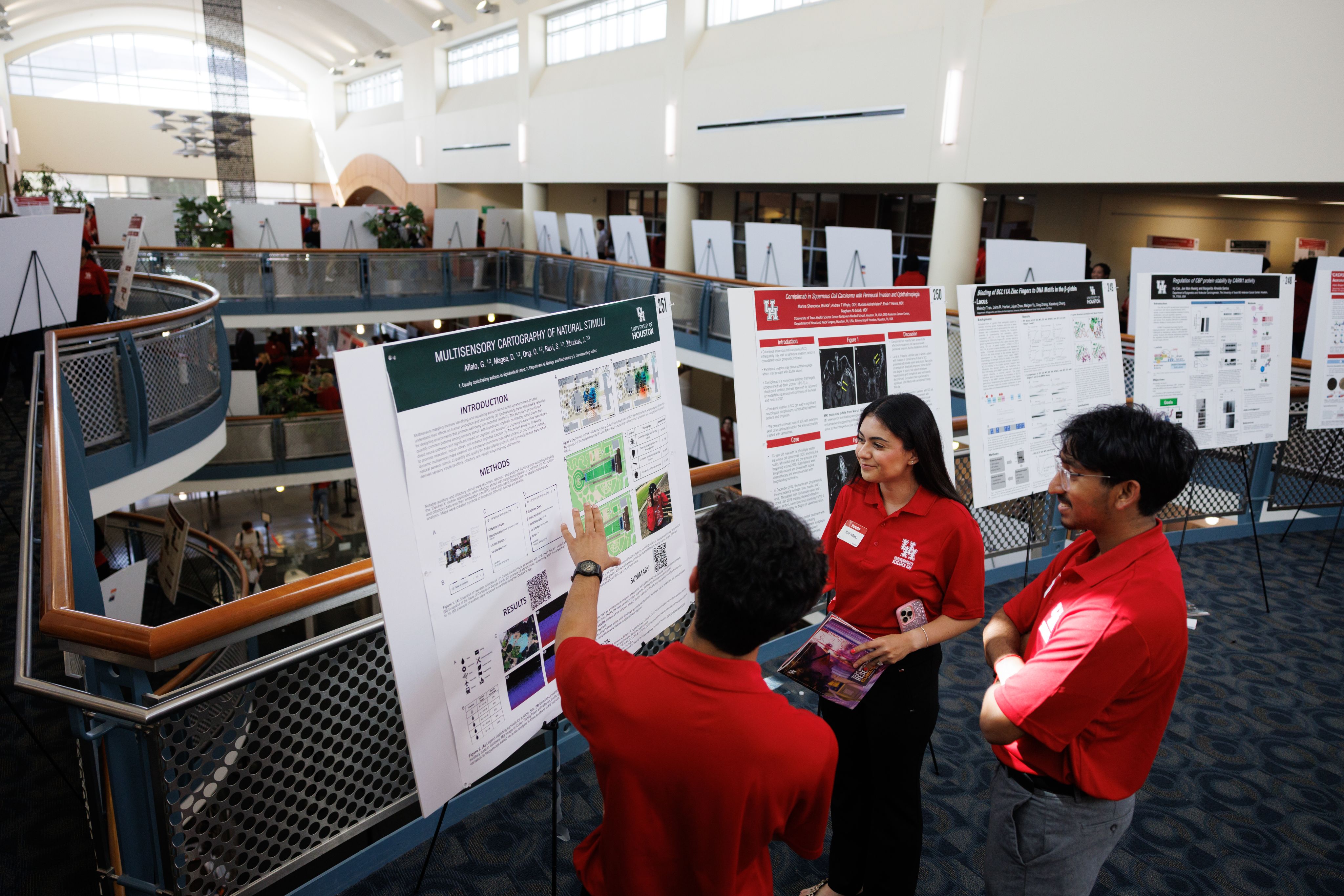Can’t Stop UH Student Researchers
Undergraduate Research Day Celebrates 20 Years with Largest-Ever Event

As University of Houston juniors Ryan Lester and Mia Lukenbill move from class to class each day, the same thought always comes to them: geez, it’s really hot outside.
That thought — one that’s not uncommon among UH students and Texans alike — is the driving force behind a year-long research project they have been pursuing; a project they hope might encourage change to campus infrastructure that could make hot days just a bit more bearable.
The pair had presented their research a couple of times previously, but on April 10 they got their third opportunity as two of 390 student presenters participating in UH’s 20th annual Undergraduate Research Day, an event that gives UH academics an opportunity to showcase work ranging from managing heat, robotics and even movies to hundreds of visitors.
The event was hosted by the Office of Undergraduate Research and Majors Awards and was held on the second floor of the MD Anderson Library.
“We wanted to go with something that might actually inspire change on campus,” said Lester, an economics major.
Like many of their peers at URD, Lester and Lukenbill went through numerous processes to get their presentation to their liking. Their aim was to study the effects of prolonged extreme heat on, specifically, college students.
To do so, they pulled data from the National Institutes of Health and Google Scholar, ultimately whittling their findings down to fit their needs. What they learned was prolonged heat could cause an increase in mortality rates, increased chance of illness, an increase in crime and a decline in cognition.
Once they compiled their findings, they presented their research to the Institutional Review Board in hopes to continue pursuing their research.
“Getting everything ready for the IRB and waiting for approval takes a long time,” said Lukenbill, who is studying public health. “It’s been a long road, but we’re nearing the end.”
The 20th Annual Undergraduate Research Day event featured more than 290 posters.
The 20th Annual Undergraduate Research Day event featured more than 290 posters.

Humble Beginnings for Student Research Event

Students present their research at UH’s 20th annual Undergraduate Research Day
Students present their research at UH’s 20th annual Undergraduate Research Day
Undergraduate Research Day launched in 2006 — after Stuart Long was appointed Associate Dean of Undergraduate Research — to provide students more opportunities for mentored undergraduate research. Prior, the opportunities were limited to 20 students per semester.
Over two decades, the program has grown by a whopping 1,400% since its first event, when a mere 27 participants presented research. To top it off, OURMA estimated this year’s event hosted approximately 1,000 students, faculty, staff and visitors, making it the largest-ever URD.
“Student presenters sometimes come in nervous, particularly if this is their first time presenting their research,” said OURMA director Rikki Bettinger. “But Undergraduate Research Day gives them a great boost of confidence. They look around and understand they’re part of a community.”
What makes URD unique is it gives students an opportunity to work with a mentor. That then serves as an extension of classroom learning by allowing students to join in on existing research projects or create their own opportunities to explore their interests.
For example, this year Carter Klebuc, a junior computer engineering major, worked alongside Aaron Becker, an associate professor at the Cullen College of Engineering, to develop a navigation system for drones that doesn’t require GPS.
The technique they used is called a coastal navigation motion planning algorithm, which equips drones with camera and lidar sensors to detect landmarks using a prebuilt map. This technique enabled Klebuc and Becker to accurately find the drone’s position in real time.
“What Becker and I found interesting about our research is coastal navigation has been used for hundreds of years,” Klebuc said. “It was a navigation technique for sailors in which they traveled along the coast and looked at landmarks like lighthouses or unique rock features. Those landmarks helped them determine the ship’s location.”

More Than Your Typical Research

Not all of URD’s research projects are anchored in science, however. In fact, OURMA encourages students from all disciplines to participate.
As visitors entered the event, signs were scattered about the showroom to direct them toward topics that could be of interest to them, ranging from medical, energy and even the humanities.
Fejiro Oweh, a senior musical theater performance and acting major, focused her project on the Black Panther film’s influence on Pan-African identity among second generation Nigerian and Black Americans.
“I remember when the movie came out, it changed my life in the way I interacted with my Black American peers,” Oweh said. “I wondered if other people experienced a similar thing.”
Oweh used content analysis from the movie, as well as in-depth interviews, to discover that the movie inspired unity and solidary in Black Americans. She noted that the movie used costumes and soundtrack inspired by different areas of Africa and combined everything together.
“A lot of Black Americans I interviewed talked about what it meant to be dark skinned and that being portrayed in a good light gave a sense of pride and empowerment,” she said.
Paul Kittle, left, vice chancellor of student affairs at UH, listens to finance major Diego Sierra explain his research.
Paul Kittle, left, vice chancellor of student affairs at UH, listens to finance major Diego Sierra explain his research.

Possible Next Steps for Students

Tessnim Mohammed, a senior architecture student, holds up her research paper about architecture sustainability.
Tessnim Mohammed, a senior architecture student, holds up her research paper about architecture sustainability.
Following URD, many students present their research at conferences, publish their work in top-tier journals or win awards. It also provides a head start to those who want to continue their academic journey and pursue a master’s degree or Ph.D.
In the case of Lester and Lukenbill, the pair are already scheduled to present their research to the Interdisciplinary Association for Population Health Science conference in Pittsburgh this fall.
“We’re currently in the process of taking responses to our surveys and transferring them into a database,” Lester said. “From there, we’ll move on to our photovoice study and present our findings using video, audio and other media.”
For Lukenbill, the project has confirmed what she suspected all along: extreme heat could pose a risk to student performance.
“We saw these same issues come up over and over in our survey; it really solidified my knowing that this is a problem,” she said. “It’s not just some small, insignificant topic.”
If all goes well, the pair hope to present their findings to UH leadership to encourage adding more green spaces, cooling zones and other heat relief areas.
“We’re aiming to be done with this by the time summer hits,” Lester said. “The ultimate end goal is to provide our research to the school and being like, ‘Hey, here are all of our ducks in row – how about a grant to make some of these changes?’”





